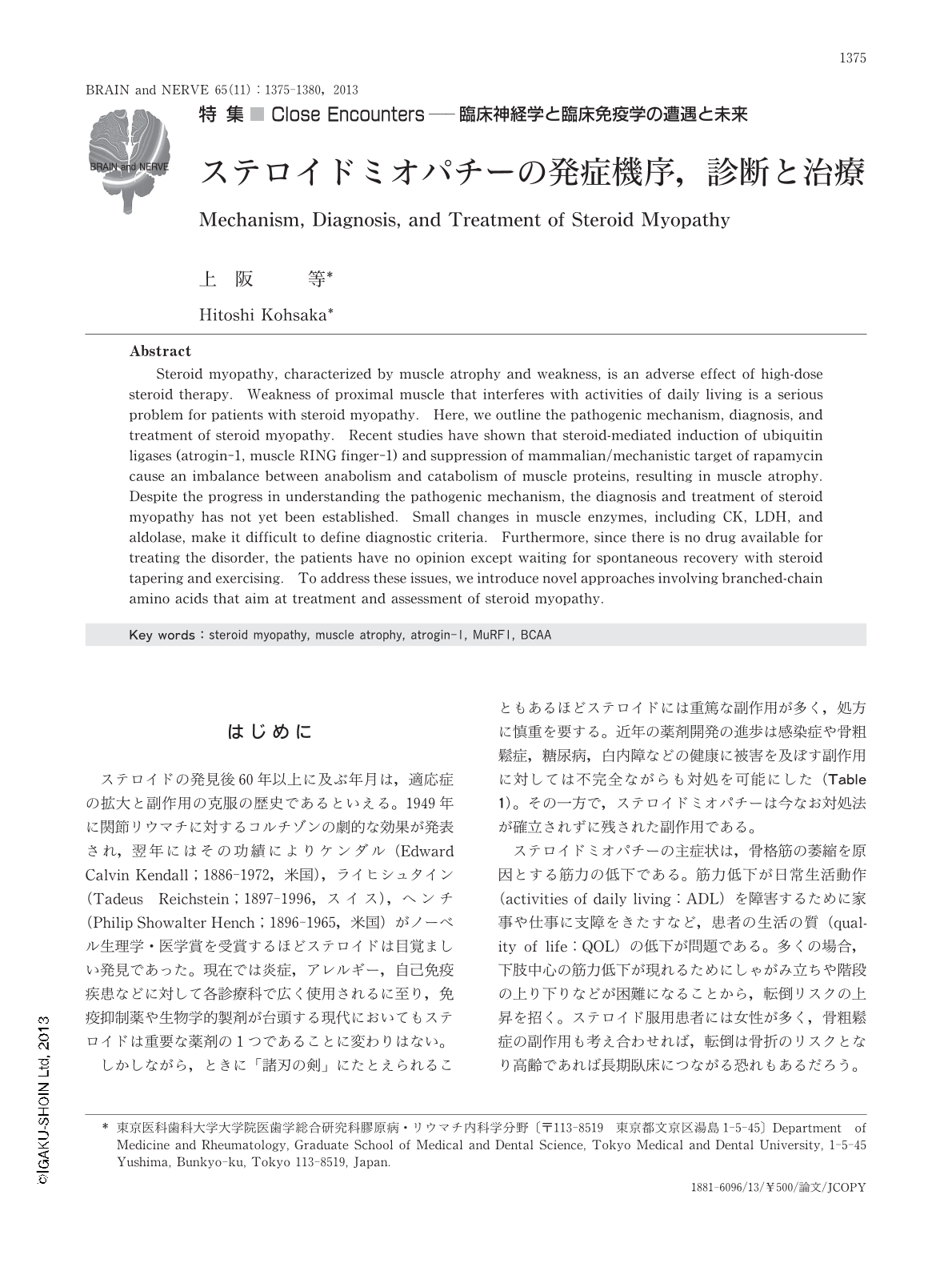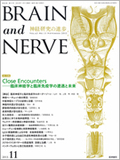Japanese
English
- 有料閲覧
- Abstract 文献概要
- 1ページ目 Look Inside
- 参考文献 Reference
はじめに
ステロイドの発見後60年以上に及ぶ年月は,適応症の拡大と副作用の克服の歴史であるといえる。1949年に関節リウマチに対するコルチゾンの劇的な効果が発表され,翌年にはその功績によりケンダル(Edward Calvin Kendall;1886-1972,米国),ライヒシュタイン(Tadeus Reichstein;1897-1996,スイス),ヘンチ(Philip Showalter Hench;1896-1965,米国)がノーベル生理学・医学賞を受賞するほどステロイドは目覚ましい発見であった。現在では炎症,アレルギー,自己免疫疾患などに対して各診療科で広く使用されるに至り,免疫抑制薬や生物学的製剤が台頭する現代においてもステロイドは重要な薬剤の1つであることに変わりはない。
しかしながら,ときに「諸刃の剣」にたとえられることもあるほどステロイドには重篤な副作用が多く,処方に慎重を要する。近年の薬剤開発の進歩は感染症や骨粗鬆症,糖尿病,白内障などの健康に被害を及ぼす副作用に対しては不完全ながらも対処を可能にした(Table1)。その一方で,ステロイドミオパチーは今なお対処法が確立されずに残された副作用である。
ステロイドミオパチーの主症状は,骨格筋の萎縮を原因とする筋力の低下である。筋力低下が日常生活動作(activities of daily living:ADL)を障害するために家事や仕事に支障をきたすなど,患者の生活の質(quality of life:QOL)の低下が問題である。多くの場合,下肢中心の筋力低下が現れるためにしゃがみ立ちや階段の上り下りなどが困難になることから,転倒リスクの上昇を招く。ステロイド服用患者には女性が多く,骨粗鬆症の副作用も考え合わせれば,転倒は骨折のリスクとなり高齢であれば長期臥床につながる恐れもあるだろう。ステロイドミオパチーを発症した場合はステロイドの減量を余儀なくされるが,ほかに治療薬がない難治性疾患の場合には,ステロイドを減量すれば原疾患の治療に支障をきたすなどのジレンマもある。
ステロイドミオパチーに対して積極的な医療介入がなされていない原因の1つは,ステロイドミオパチーの診断法が確立されていないために診断基準の整備が進まず,疾患としての明確な定義づけがなされていないことにある。このため,診断の方法は医師の裁量に委ねられているのが現実である。原疾患や対処法のある副作用のみならず筋症状にも留意しながら治療を行わない限り,ステロイドミオパチーの発症が見逃されるケースもある。わが国で膠原病患者を対象に行われた近年のアンケート調査では,314名中118名(38%)の患者がステロイド治療中に筋力低下を自覚していたことを訴えたという1)。
このような混沌とする状況の打開に資するべく,本稿ではステロイドミオパチーの発症機序と,診断および治療の現状を概説する。そして,ステロイドミオパチーがしばしば問題となる多発(性)筋炎・皮膚筋炎(polymyositis/dermatomyositis:PM/DM)の実態とともに,それに対する新たな取り組みを紹介したい。
Abstract
Steroid myopathy, characterized by muscle atrophy and weakness, is an adverse effect of high-dose steroid therapy. Weakness of proximal muscle that interferes with activities of daily living is a serious problem for patients with steroid myopathy. Here, we outline the pathogenic mechanism, diagnosis, and treatment of steroid myopathy. Recent studies have shown that steroid-mediated induction of ubiquitin ligases (atrogin-1, muscle RING finger-1) and suppression of mammalian/mechanistic target of rapamycin cause an imbalance between anabolism and catabolism of muscle proteins, resulting in muscle atrophy. Despite the progress in understanding the pathogenic mechanism, the diagnosis and treatment of steroid myopathy has not yet been established. Small changes in muscle enzymes, including CK, LDH, and aldolase, make it difficult to define diagnostic criteria. Furthermore, since there is no drug available for treating the disorder, the patients have no opinion except waiting for spontaneous recovery with steroid tapering and exercising. To address these issues, we introduce novel approaches involving branched-chain amino acids that aim at treatment and assessment of steroid myopathy.

Copyright © 2013, Igaku-Shoin Ltd. All rights reserved.


